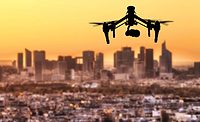Researchers at Virginia Tech have found that small consumer drones are unlikely to cause severe head injuries if they fall out of the sky and strike people.
A study found that a catastrophic head injury was less than 5 percent in an impact with a 2.6-pound (1.2-kilogram) unmanned vehicle, according to results published in the Annals of Biomedical Engineering.
The study focused solely on head trauma and didn’t assess the potential for rotor blades cutting the skin or other injuries.
Larger drones create higher risks of injury, which may limit their uses until other safety standards can be devised, the study found.
“Risk of injury was observed to increase with increasing UAS mass, and the larger models tested are not safe for operations over people in their current form,” the researchers, led by biomechanical professor Steven Rowson, said in the journal article, referring to drones as unmanned aircraft systems.
The risks of a head injury are also greater if a drone falls on a person than if it runs into them while flying, the study said.
The Virginia Tech study looked at three models made by China-based SZ DJI Technology. The smallest was the Phantom 3, which was flown straight into a crash-test dummy’s head and also dropped on the dummy to simulate falling from the sky.
While the risks from the Phantom 3 were minimal, the potential for injury increased dramatically as drones weighed more. A DJI S1000+ model, an eight-rotor copter weighing 24 pounds (11 kilograms) had an injury risk of about 70 percent in some tests.
http://www.bmes.org/content.asp?contentid=213









